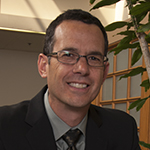A special supplemental issue of the American Journal of Preventative Medicine titled, “Research Collaboration with 2-1-1 to Eliminate Health Disparities” was recently published, marking the first time a journal has focused entirely on scientific research conducted within 2-1-1 systems. And Washington University in St. Louis researchers played a key role in the publication.

“This special issue is the first to really document and quantify some of the benefits provided from 2-1-1 assistance,” says Matthew W. Kreuter, PhD, professor and director of the Brown School’s Health Communication Research Laboratory (HCRL) and one of four guest editors.
2-1-1, a nationally designated three-digit telephone exchange like 9-1-1, is an information and referral system that serves millions of Americans living in poverty. Callers speak to an information and referral specialist who identifies their needs and provides referrals to local resources.
Kreuter’s center and Washington University have been at the hub of research into 2-1-1 and currently lead a national working group that studies the service.
“We’ve been working with 2-1-1 for about 7 years now, locally, with 2-1-1 Missouri, having the United Way serve as a major community partner, as well as 2-1-1s across the U.S,” Kreuter says.
In a study titled, “Use of Cancer Control Referrals by 2-1-1 Callers: A Randomized Trial,” Kreuter and other researchers tried to integrate health referrals into 2-1-1 so that when people call about other concerns, they can proactively address health needs as well.
Kreuter found that using telephone health coaches — called “navigators” — to help refer callers to health services such as mammograms, Pap tests and smoking cessation increased the chances that the callers would contact those services.
His study was “the first to demonstrate that proactive referrals made to 2-1-1 callers . . . motivated calls for follow-up cancer control services,” wrote Laura A. Linnan, ScD, of the University of North Carolina, a guest editor of the supplement.
Now, researchers at the HCRL are working to find out if those callers followed through and used the services to which they were referred. Because 2-1-1 reaches large numbers of poor people, many of whom have health problems, even a modest positive response could make a big difference if implemented nationally, Kreuter says.
“What all this work reveals is how we can do a better job of serving the health needs of low-income and vulnerable people by partnering with agencies that already do a good job of serving their other needs,” he says.